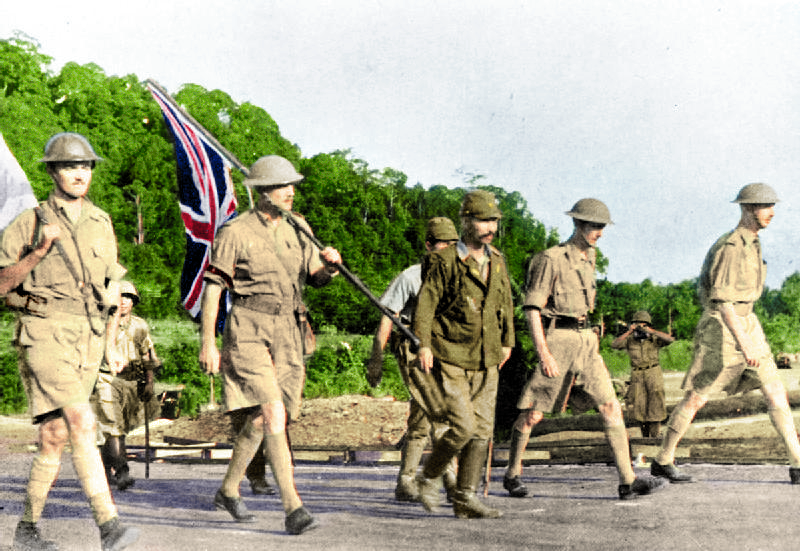14 February 1942
UK : RAF Bomber Command began to deploy the new GEE radio navigation device.
British Deputy Chief of Air Staff and Air Ministry informed the RAF Bomber Command that “the primary object of your operations should be focused on the morale of the enemy civilian population.” German civilian population are designated as legit targets from now on.
Allied convoy PQ-11 outbound to Russia departed Kirkwall, Scotland, United Kingdom
East Mediterranean : Royal Navy submarine HMS Thrasher survived an attack off Crete with two unexploded bombs lodged in its deck casing. Lieutenant Peter Roberts and Petty Officer Thomas Gould took 40 minutes to remove the explosives, squeezed in the narrow confines knowing the submarine might by forced to dive at any moment, leaving them trapped to drown. They both received the Victoria Cross.
Mediterranean Sea : Royal Navy submarine HMA P38 torpedoed and sank Italian transport ship Ariosto in the Mediterranean Sea without realizing that of the 410 aboard, 294 of them were Allied prisoners of war. 252 survivors of the sinking were rescued by Italian destroyer Premuda and torpedo boat Polluce.
Atlantic Ocean : German submarine U-576 torpedoed and sank British catapult armed merchant (CAM) ship Empire Spring southeast of Nova Scotia, Canada at 0337 hours, killing all 53 aboard
Caribbean Sea : Panaman tanker Penelope was torpedoed and sunk by German submarine U-67 in Caribbean Sea.
British troopship Clan Chattan was bombed and sunk by Luftwaffe FW-200 bombers , all 358 passangers and crew aboard were escued by Royal Navy escorts though.
Mindanao , Philippines : US submarine USS Sargo delivered 1 million rounds of .30 caliber ammunition to Mindanao, Philippine Islands. Upon departure, the submarine evacuated 24 US Army personnel
US submarine USS Swordfish torpedoed and sank Japanese transport Amagisan Maru 91 miles east of Davao, Mindanao, Philippine Islands.
Burma : Indian 17th Infantry Division was ordered to defend against the Japanese advance toward Rangoon, Burma at the Bilin River.
Ceylon , Indian Ocean : Japanese submarine I-166 torpedoed and sank British freighter Kamuning 2 miles east of Ceylon at 0817 hours; 6 were killed, 63 survived.
Sumatra , Dutch East Indies : 760 paratroopers of Japanese 1st Airborne Division landed at Pangkalanbenteng airfield near Palembang, Sumatra, Dutch East Indies to capture airfield and oil refineries nearby ; in response, ABDA command sent 5 cruisers and 11 destroyers to transport troops to Palembang; Dutch destroyer HNLMS Van Ghent in this force ran aground on the next day and would be scuttled. At the same time a Japanese task force of 25 ships mostly amphibious transports commanded by Admiral Ozawa are approaching to land troops to Palambang. From this task force Japanese troop transport Inbassan Maru was bombed and sunk by RAF Bristol Bleinheim bombers from Sumatra
Meanwhile, the British cargo ship Vyner Brooke, escaping from Singapore with 300 on board, was bombed off Sumatra by Japanese aircraft ; around 100 survivors, including 22 Australian nurses, reach shore on Banka island; the men were marched away by the Japanese and bayoneted and shot, the wounded were bayoneted where they laid, and the nurses were herded into the sea and machine gunned; one, Sister Vivian Bulwinkel, was wounded but survived to tell of the atrocity; she died in 2000, aged 85.
Royal Navy Motor gunboat HMS Kuala was bombed and sunk by Japanese aircraft off Pompong island, Dutch East Indies. Many survivors made it to land nearby. Same day 31 other ships and medium sized boats left Singapore full of troops , military personnel and civilians evacuated from Singapore island , 12 of them sunk by Japanese aircraft or patrolling destroyers off Singapore , the rest and managed to reach Java intact.
Java Sea : The British Royal Navy riverboat HMS Li Wo, evacuating military personnel from Java, ran into part of the Japanese invasion fleet and was blasted to pieces by Japanese destroyers. In a last desperate show of defiance, the little boat rammed one of the enemy transports (which would sink on the following day) before going down. Only 13 of the 120 aboard Li Wo survived. The commander, Lieutenant Thomas Wilkinson, who went down with his vessel, was awarded a posthumous Victoria Cross in 1946.
Singapore : While Japanese troops penetrated the lines manned by the 1st Malay Brigade at Singapore and reached the Alexandra Barracks Hospital, where 323 hospital staff and patients would soon be brutally massacred, General Archibald Wavell rejected Arthur Percival’s request to surrender Singapore despite the town is under heavy Japanese gunfire and air bombartment. Same day Singapore’s 15 inch naval guns facing sea were put out of action by their gunners.
Despite being wounded, Lt. Adnan bin Saidi continued to retire from his forward position in Singapore. When his position was finally taken by Japanese troops, he was tied to a tree and bayoneted to death.
